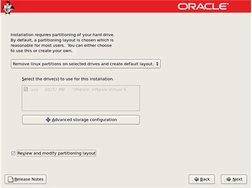| Skip Navigation Links | |
| Exit Print View | |

|
Sun Server X2-4 (formerly Sun Fire X4470 M2) Installation Guide for Linux Operating Systems |
| Skip Navigation Links | |
| Exit Print View | |

|
Sun Server X2-4 (formerly Sun Fire X4470 M2) Installation Guide for Linux Operating Systems |
Part I Linux Software Installation on x86 Servers
1. Assisted OS Installation With Oracle Hardware Installation Assistant
Oracle Hardware Installation Assistant Task Overview
How to Obtain Oracle Hardware Installation Assistant
Oracle Hardware Installation Assistant Documentation Resources
Supported Linux Operating Systems
Linux Installation Prerequisites
Linux Installation Task Overview
Oracle Unbreakable Enterprise Kernel for Linux
Installing Oracle Linux 5 Using a PXE Network Environment
Install Oracle Linux 5 Using PXE Network Boot
Oracle Linux Post Installation Tasks
Register Oracle Linux and Activate Automatic Updates
Installing Oracle Unbreakable Enterprise Kernel for Linux Using Local or Remote Console
Install Oracle Unbreakable Enterprise Kernel for Linux Using Local or Remote Console
4. Installing SUSE Linux Enterprise Server
Installing SLES 11 SP1 Using Local or Remote Media
Installing SLES 11 SP1 Using a PXE Network Environment
5. Installing Red Hat Enterprise Linux
Installing RHEL 5.5 or 6.0 Using Local or Remote Media
Installing RHEL 5.5 or 6.0 Using a PXE Network Environment
Installing the Oracle Unbreakable Enterprise Kernel for Linux
6. Getting Server Firmware and Software
Firmware and Software Access Options
Available Software Release Packages
Accessing Firmware and Software
Part II Linux System Administrator References
A. Supported Installation Methods
B. Supported Operating Systems
C. BIOS Defaults for New Installations
The following procedure describes how to boot the Oracle Linux operating system installation from local or remote media. The procedure assumes that you are booting the Oracle Linux installation media from one of the following sources:
Oracle Linux 5.5 (or subsequent release) CD or DVD set (internal or external CD/DVD)
Oracle Linux 5.5 (or subsequent release) ISO DVD image (network repository)
Note - If you are booting the installation media from a PXE environment, refer to Installing Oracle Linux 5 Using a PXE Network Environment for instructions.
Prior to performing the installation, the following requirements must be met:
All applicable installation prerequisites for installing an operating system should have been met. For further information about these prerequisites, see Chapter 2, Getting Started.
An installation method (for example: console, boot media, and install target) should have been chosen and established prior to performing the installation. For more information about these setup requirements, see Appendix A, Supported Installation Methods.
After completing this procedure, you should review and perform the required post installation tasks described later in this chapter. For more details, see Oracle Linux Post Installation Tasks. You can also install the Oracle Unbreakable Enterprise Kernel for Linux on top of Oracle Linux 5.5 or later release. For more information, see Installing Oracle Unbreakable Enterprise Kernel for Linux Using Local or Remote Console.
Note - The following steps use Oracle ILOM 3.1 command syntax. If you are using Oracle ILOM 3.0, refer to the Oracle ILOM 3.0 Documentation Collection at http://www.oracle.com/pls/topic/lookup?ctx=ilom30.
The BIOS screen appears.
Note - The next events occur very quickly; therefore, focused attention is needed for the following steps. Watch carefully for these messages as they appear on the screen for a brief time. You might want to enlarge the size of your screen to eliminate scroll bars.
The Please Select Boot Device menu appears.
The device strings listed on Boot Device menu are in the format of: device type, slot indicator, and product ID string.
After a few seconds, the splash screen for the Oracle Linux 5 installation appears. The bottom half of the splash screen lists instructions, function keys, and the boot prompt.
Alternately, for text mode, enter the following command:
boot: linux text

The Keyboard Type screen appears.
The Installation Method screen appears.
The CD Found screen appears.
The Oracle Linux 5 screen appears.
The Installation Number dialog appears.
The Disk Partition Setup screen appears.

Note - If Oracle Solaris OS or Oracle VM is preinstalled on the disk, you can choose to partition the disk to remove the preinstalled OS; or, you can choose to keep the preinstalled OS and partition the disk to support dual-boot operating systems.
Note - For detailed installation instructions, see the Red Hat Enterprise Linux: Installation Guide at http://www.redhat.com/docs/manuals/enterprise
For installation instructions, see Installing Oracle Unbreakable Enterprise Kernel for Linux Using Local or Remote Console.